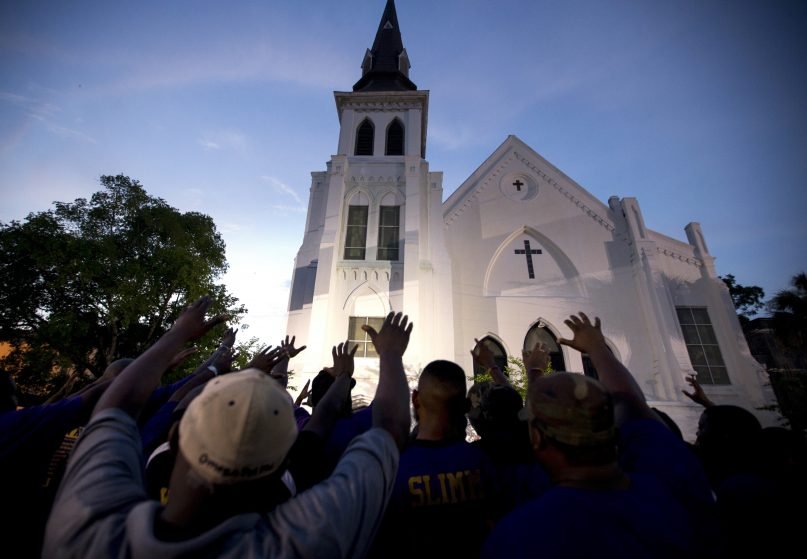(RNS) — In late April of 2015, the Rev. Clementa Pinckney, senior pastor of Mother Emanuel African Methodist Episcopal Church in Charleston, South Carolina, opened a “Requiem for Racism” program by praying:
We know only love can conquer hate, that only love can bring all together in your name. Irregardless of our faiths, our ethnicities, where we are from, together we come in love, together we come to bury racism, to bury bigotry, and to resurrect and revive love, compassion, and tenderness.
Two months later, Pinckney and eight of his parishioners were murdered during a Bible study in the church basement by 21-year-old Dylann Roof, a neo-Nazi intent on starting a race war in America. Eighteen months later, the election of Donald Trump as U.S. president would usher in a revival of white supremacy around the country.
So much for the requiem.
Pinckney’s prayer is quoted in “Mother Emanuel,” Kevin Sack’s exceptional new book about the church from its antecedents in colonial Methodism through the murders, Roof’s trial (which Sack covered for The New York Times) and the aftermath. Like the nonpareil journalist-biographer Robert Caro, Sack both interviewed a vast number of sources and turned every page of the archival and historiographic record.
The resulting intimate, unvarnished story of one unique church in one unique city opens a window onto religion and race relations across American history. If there’s a lesson to be drawn, it’s that the arc of the moral universe twists and turns at least as much as it bends toward justice.
Early Methodism attracted Black people, both free and enslaved, because of its opposition to slavery — and repelled white Southerners for the same reason. By 1815, Black Methodists outnumbered white Methodists in Charleston by a ratio of 13-to-1 and had been accommodated with a degree of autonomy by the white leaders of the denomination.
That year a new “preacher-in-charge” reversed the accommodations, leading many of his Black congregants to decamp and join a church built by members of their community that was allied with the Philadelphia-based African Methodist Episcopal Church. But they were forced to dismantle it in 1822 by white Charlestonians freaked out by the Denmark Vesey affair — an abortive insurrection plot whose significance historians continue to debate. Religion under the white thumb was now the rule in South Carolina, with education of Blacks forbidden and southern Methodism itself reconciled to slavery.
Not until after the Civil War did Black Methodism reestablish itself in the South — in Charleston with the construction of Emanuel AME. The church became a hub for political self-assertion during Reconstruction. (Sack’s experience as a political reporter gives him a purchase on the subject lacking in most historians of religion.)
The resulting iteration of white supremacy in the South did not, this time, entail religious repression. As Sack puts it, “If anything, the forced removal of Black Southerners from American politics only made the Black church more vital following the deconstruction of Reconstruction.” In due course, Mother Emanuel became a hub of resistance to Jim Crow and a central player in the civil rights movement in Charleston.
The post-civil rights era has been less kind to the church. The gentrification of Charleston forced many members to move away and its adherence to traditional social mores and liturgical practices led younger people to look for more contemporary places to worship. The murders did lead to an influx of support, but the church was ill-equipped to handle the money. That’s part of the story too.
Sack is a Jewish son of the South who grew up in Jacksonville, went to college at Duke and spent most of a brilliant journalistic career living in Atlanta while working for the Atlanta Journal Constitution and the Los Angeles Times as well as the New York Times — before moving to Charleston during the writing of the book. Ten years in the making, “Mother Emanuel” is something of a white Southerner’s quest to understand how Black Southerners coped, and continue to cope, with slavery and its legacy.
Beginning with a horrific account of the shooting, the book ends with an epilogue that explores the significance of the expressions of forgiveness that have so often marked the response of Black Christians to this and other outrages perpetrated on them. The fact that Dylann Roof has remained incorrigibly unrepentant makes the response all the more puzzling.
Sack’s central claim, derived from philosophers and prelates and students of Black America, is that forgiving the likes of Roof is not about freeing him from culpability but enabling the forgiver to achieve a degree of agency and moral superiority. And also, there’s what an octogenarian member of Mother Emanuel told Sack:
“Hatred doesn’t do anything for anybody. You’re drinking poison while waiting for the other guy to die. But when you’ve been traumatized for four hundred years it kind of makes you different from someone who has not been traumatized at all. It hurts them more than it hurts you because we’ve been through it. You’re always thinking, ‘Yeah, I’ve seen this before.’ It hurts but you don’t hold on to it as long because the next day you have to do some other stuff. The world just doesn’t change that fast.”




Recent Comments